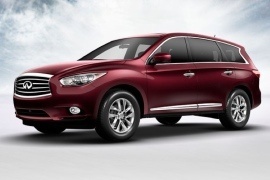Infiniti decided to change its vehicles’ name and rechristened the JX35 as a QX60 for the 2014 model.
The QX60 was designed as a seven-seat vehicle to compete against the Audi Q7 or the BMW X5. Unlike the German rivals, it was available as a front- or all-wheel-drive vehicle, which allowed the Japanese carmaker to offer the SUV at a lower price than its competition and, moreover, to brag about its high fuel efficiency. The strategy worked, and the QX60 was a commercial success.
At the front, the car sported the same chrome-plated grille with horizontal slats. Its swept-back headlights featured corner-mounted turn signals in a narrow angular shape. The design team installed a curved, wrapped-around bumper at the front, with lines going on the sides on the front fenders. Depending on the trim option, the QX60 was available with chromed 20” light-alloy wheels.
Since it was based on the same platform as the Nissan Pathfinder, the QX60 featured a long wheelbase that allowed the carmaker to install standard three-seat rows. At the front, the carmaker installed a sloped-down dashboard with a rounded instrument cluster in front of the driver. On top of the center stack, Infiniti placed the infotainment system with its specific controls underneath. Its screen was not touch-sensitive. Unlike other carmakers, the seven seats were true to their words, offering adequate room even on the third row, while Infiniti spoiled the first and second-row occupants in comfort.
Under the hood, the QX60 was offered with a choice of gasoline or hybrid drivetrains, with either a front- or an all-wheel-drive system. The standard transmission for all versions was a CVT-type gearbox.

























































